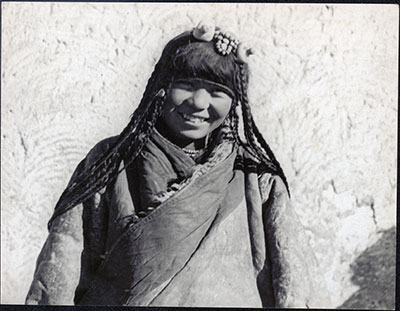
1998.131.289 (Print black & white)


1998.131.289 (Print black & white)

Frederick Spencer Chapman
Frederick Spencer Chapman
January 15th 1937
Lhasa Area >
1998.131.289
82 x 107 mm
Print gelatin silver
Donated 1994
Faith Spencer Chapman
British Diplomatic Mission to Lhasa 1936-37
Frederick Spencer Chapman
2.3 [view film roll]
SC.T.2.289
Notes on print/mount - Notes on print/mount - The number '2/3' has been written on the centre back of the print in pencil. This relates to the numbering system that Chapman adopted for images taken whilst on the British Mission to Lhasa in 1936-37. [MS 2/4/2005]
Manual Catalogues - Caption in Chapman's hand-written list of negatives made whilst on the Mission to Lhasa, 1936-7 [See PRM Manuscripts Collection]: 'Amazing headdress of nomad woman (out of focus)' [MS 18/03/2006]
Other Information - Related Images: The girl in this photograph can also be seen in 1998.131.288 & 1998.131.290 [MS 2/4/2005]
Other Information - Related Images: Images prefixed with '2' comprise a group of negatives including images of Khampa people, Kinchung, a shuttle cock game and images of the Regent’s palace. They all seem to have been taken between January 15th and 27th 1937 [MS 18/03/2006]
Other Information - Cultural Background: Other images with a '2' prefix are used to illustrate the official Mission Diary for this month. Furthermore, it seems that it was during January 1937 that Chapman took a particular interest in photographing and recording in text the various groups of nomads that were coming to Lhasa to pay their taxes at the Potala, to make pilgrimage and to participate in the New year festivities that would take place in early February. They were frequently to be found on the Linghkor Sacred Way around Lhasa at this time of year and Chapman paid much attention to the styles of women's head dress that he encountered. On January 7th Chapman rose early to photograph nomads encamped on the outskirts of Lhasa, although this photograph was taken in the city itself on another occasion. [MS 18/03/2006]
Other Information - Description: In the introduction to the Mission Diary Part XIII (January 15th to 31st) Chapman wrote: "Most of the travellers are nomads from the Chang Thang or the Hor and Kham provinces. They wear a single voluminous garment of sheepskin hitched up with a girdle to facilitate walking. Unlike the inhabitants of Lhasa these men have their hair fairly short - that is to say in a tousled black mop - and they usually go hatless. While the women-folk have their hair done in the most intricate fashion and often adorned with a variety of strange ornaments. Many of them wear on top of their heads several pieces of amber exactly resembling a cake of ochre-coloured soap, surmounted by a coral the size of a cherry." He wrote a similar description in his book Lhasa the Holy City [London: Chatto & Windus, 1938; reprint, London: Readers Union Ltd., 1940]: "Some women wear two lumps of amber as big as plums on top of their heads, and usually a few turquoises or corals between. Sometimes strips of black, green, or scarlet cloth are sewn onto the border and sleeves of the sheep-skin garment. This is very effective" [1940, p.159] [MS 2/4/2005]
For Citation use:
The Tibet Album.
"Nomad girl"
05 Dec. 2006. The Pitt Rivers Museum.
<http://tibet.prm.ox.ac.uk/photo_1998.131.289.html>.
For more information about photographic usage or to order prints, please visit the The Pitt Rivers Museum.
© The Pitt Rivers Museum